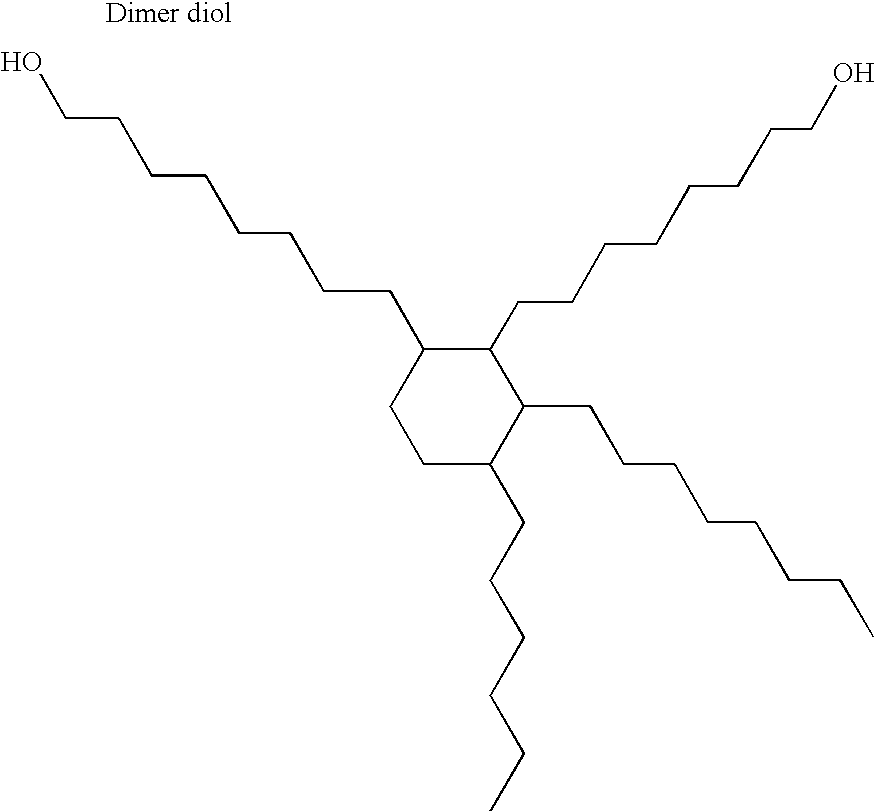Magnetic recording medium
- Summary
- Abstract
- Description
- Claims
- Application Information
AI Technical Summary
Benefits of technology
Problems solved by technology
Method used
Image
Examples
synthesis example pub-1
(1) Synthesis of Polyester Polyol A
[0099]To a reaction vessel equipped with temperature gauge, stirrer, and reflux cooler, 365 parts of adipic acid and 260 parts of neopentyl glycol were charged. 2 mass percent quantity of zinc acetate and 3 mass percent quantity of sodium acetate were added as catalysts, a transesterification was conducted for 3 hours at 180 to 220° C., and a polycondensation was conducted for 2 hours at a reduced pressure of 1 to 10 mmHg. Polyester polyol A was thus obtained.
(2) Synthesis of Polyurethane Resin PUB-1
[0100]Next, the polyester polyol obtained as set forth above was employed, and in the same manner as in Embodiment PUA-1, the chain extending agent and organic diisocyanate compound indicated in Table 1 were employed to obtain polyurethane resin PUB-1. The hydrophilic polar group (—SO3Na) content of the polyurethane resin PUB-1 obtained was 0.339 eq / g.
synthesis examples pub-2
, PUB-3, AND PUb-4
Synthesis of Polyurethane Resins PUB-2, PUB-3, and PUb-4
[0101]In the same manner as in Synthesis Example PUB-1, the polyester A, chain extending agent, and organic diisocyanate compound indicated in Table 1 were used to prepared polyurethane resins PUB-2, PUB-3, and PUb-4. The hydrophilic polar group (—SO3Na) content of the polyurethane resins PUB-2, PUB-3, and PUb-4 obtained are given in Table 1.
synthesis example
PVC-1
Synthesis of Vinyl Chloride Resin PVC-1
[0102]To a polymerization reaction vessel, 130 parts of deionized water, 117 parts of methanol, 0.6 part of methyl cellulose, 0.2 part of polyoxyethylenesorbitan fatty acid partially esterified compound, and 0.52 part of trichloroethylene were charged. After evacuating the gas within the system under reduced pressure, the vinyl chloride monomer, glycidyl allyl ether, and 2-hydroxypropyl methacrylate shown in Table 1 were introduced and the mixture was stirred at 60° C. Subsequently, 0.42 part of 3,3,5-trimethylhexanoyl peroxide was added and polymerization was initiated. Simultaneously, a solution of 8 parts of sodium p-styrenesulfonate dissolved in 40 parts of methanol was continuously added at a fixed rate designed to complete addition of the entire solution in 8 hours. After the reaction had progressed for 12 hours, the polymerization reaction vessel was cooled when the pressure therein reached 3 kg / cm2, yielding vinyl chloride resin PV...
PUM
| Property | Measurement | Unit |
|---|---|---|
| Percent by mass | aaaaa | aaaaa |
| Percent by mass | aaaaa | aaaaa |
| Percent by mass | aaaaa | aaaaa |
Abstract
Description
Claims
Application Information
 Login to View More
Login to View More - R&D
- Intellectual Property
- Life Sciences
- Materials
- Tech Scout
- Unparalleled Data Quality
- Higher Quality Content
- 60% Fewer Hallucinations
Browse by: Latest US Patents, China's latest patents, Technical Efficacy Thesaurus, Application Domain, Technology Topic, Popular Technical Reports.
© 2025 PatSnap. All rights reserved.Legal|Privacy policy|Modern Slavery Act Transparency Statement|Sitemap|About US| Contact US: help@patsnap.com

